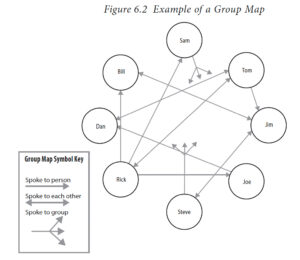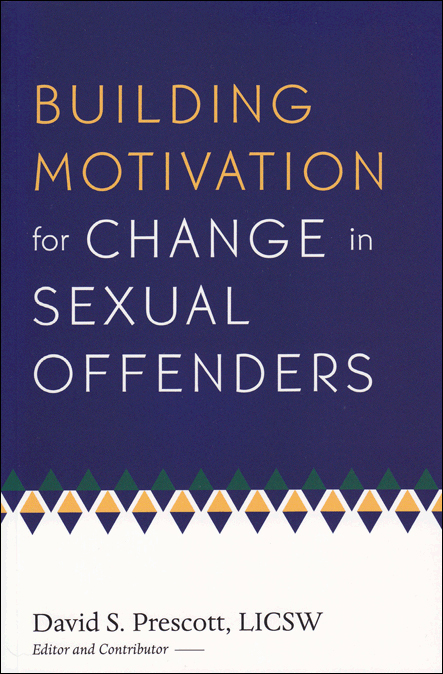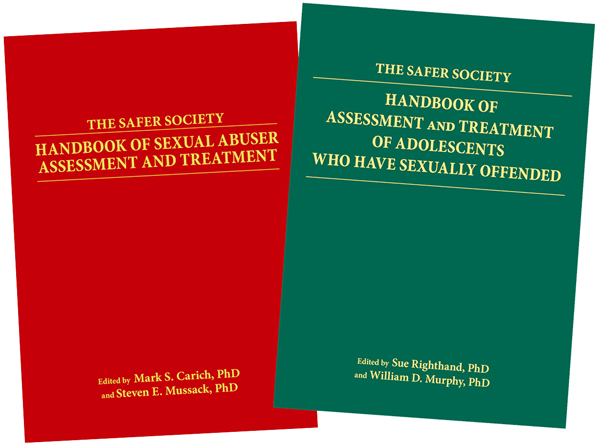Our organization offers a comprehensive collection of publications designed for professionals, families, and individuals who have experienced abuse. Our online store features a diverse selection of resources, including professional guides, workbooks, and educational materials
Orders Shipped Within the United States:
Receive free shipping on book orders of $100 or more!
(excludes training registration fees)
Home / Shop / For Adult Clients / Professional Books for Working with Adult Clients
Safer Society Handbook of Sexual Abuser Assessment and Treatment

- Description
- Specifications
The Safer Society Handbook of Sexual Abuser Assessment and Treatment
edited by Mark S. Carich & Steven E. Mussack
Now you can earn 12 CE Credits for reading the Handbook.
Click here for details.
This comprehensive handbook serves as an invaluable resource for psychotherapists working with sexual abusers, offering a wealth of evidence-based approaches to assessment and treatment. Spanning the entire process from initial evaluation to aftercare, the handbook provides detailed guidance on conducting psychosexual evaluations, implementing effective therapeutic techniques, and addressing special populations. By integrating research with clinical best practices across four major sections—Assessment, The Therapeutic Context, Treatment Components, and Special Concerns—this volume equips clinicians with the knowledge and tools to deliver more effective interventions aimed at reducing recidivism and promoting offender rehabilitation.

A “Group Map” – a visual representation of member interactions in a group therapy setting with two active co-facilitators, Steve and Sam. Individual members of the group are positioned in relation to one another and lines indicate the communication dynamics. This helps to identify communication patterns, such as dominant and non-contributing members, potential conflicts, and alliances within the group
Part I: Assessment focuses on the psychosexual evaluation process and components, risk assessment methods and tools, and the Risk-Need-Responsivity (RNR) framework. This section provides guidance on conducting comprehensive evaluations to gather information about an offender's history, risk factors, and treatment needs. It emphasizes the importance of using multiple assessment methods and validated risk assessment instruments to develop an accurate understanding of the individual.
Part II: The Therapeutic Context covers program development and management, therapeutic processes, motivating clients to change, and facilitating client-centered treatment. This section also covers how to create an effective treatment environment, build therapeutic alliances with clients, and use motivational techniques to engage offenders in the change process. It highlights the importance of high quality group therapy facilitation, as it is the primary modality for sexual offender treatment.
Part III: Treatment Components examines cognitive factors in sexual offending, building self-esteem and relationship skills, the Good Lives Model of rehabilitation, behavioral techniques for controlling sexual arousal, trauma-informed care, and family therapy approaches. This section outlines key elements of comprehensive sexual offender treatment, including addressing cognitive distortions, developing prosocial skills, safety planning, and incorporating a holistic, strengths-based approach to rehabilitation.

A sample Safety Plan for the “Smith” family. The plan includes comprehensive guidelines for ensuring safety and supervision due to prior inappropriate behavior. The plan is signed by all parties involved, reinforcing their commitment to maintaining a safe environment.
Part IV: Special Concerns addresses working with intellectually disabled clients, internet pornography and sexual offending, and the assessment and treatment of female sexual offenders. This section provides guidance on tailoring treatment approaches for specific offender populations that may have unique needs or risk factors. It highlights the importance of considering individual differences when developing treatment plans.
From the Preface:
“This book emphasizes what the field of sexual offender treatment has learned from other areas of psychology. For treatment to be effective, it is essential for therapists to treat clients with positive regard and motivate them to constructively engage in an examination of the patterns of thinking and behavior that led them to harm others. Consequently, the overarching construct that unifies the chapters in this book is the integration of positive psychology principles with cognitive-behavioral therapy. The sequence of topics covered in the book spans the assessment and treatment of a sexual offender from the time he first enters the correctional system and is assigned to a treatment program to his ultimate release from prison or parole and discharge from treatment.”
The emphasis on individualized, holistic treatment approaches, coupled with insights from leading experts in the field, makes this handbook an essential reference tool that should sit on the desk of every novice and experienced therapist navigating the complex challenges of sexual offender treatment.



